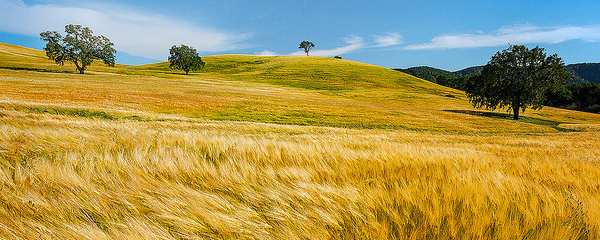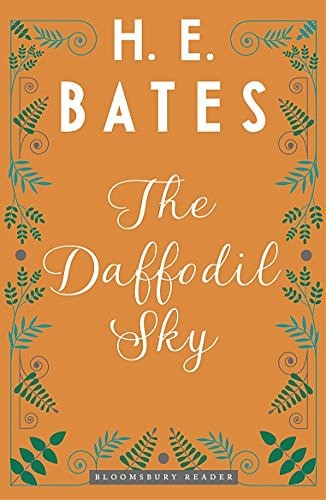
('Wheat in the Wind' © Malcolm Carlaw, 2014)
GRIST AND GRAIN IN H. E. BATES’ ‘THE MILL’ AND ‘THE GOOD CORN’
by MIKE SMITH
I recently stumbled upon a copy of H. E. Bates’ 1955 short story collection The Daffodil Sky & other Stories. On the cover is a quotation from a reviewer: ‘contains some of the best tales he has written.’ I wonder if there might be a whiff of comic irony in the comment, for Bates went into print complaining of A. E. Coppard’s use of the ‘T’ word ‘on every fly leaf.’
There are some exceedingly good tales in the collection, though, and high on my list would be the opening story, ‘The Good Corn’. For me, this is a classic Bates tale, and a classic English one too, set in the rural England imagined during my childhood where small farmers could be depicted ‘getting a living from raising hens and geese, a few cows and calves, the fruit from half a dozen cherry trees, and an acre or two of corn.
The story tells of a childless couple, a small farmer and his wife, who re-start their lives after a health scare by moving from a mixed farm to an arable one, and by taking on a young girl helper.
 It’s a storyline similar to the bleaker narrative found in ‘The Mill’. In that story a young girl is also taken on to help an older couple. In ‘The Good Corn’ the couple are shown working together right from the beginning, yet their failure to have children has driven them apart, and, sexual relations between them have ended, as is implicit in the line: “Don’t come near me. I’m no good to you.” In ‘The Mill’, the story begins with the girl’s family situation, and the couple she is sent to are shown as being separate, the man ‘out’ at work, the woman, ill, at home.
It’s a storyline similar to the bleaker narrative found in ‘The Mill’. In that story a young girl is also taken on to help an older couple. In ‘The Good Corn’ the couple are shown working together right from the beginning, yet their failure to have children has driven them apart, and, sexual relations between them have ended, as is implicit in the line: “Don’t come near me. I’m no good to you.” In ‘The Mill’, the story begins with the girl’s family situation, and the couple she is sent to are shown as being separate, the man ‘out’ at work, the woman, ill, at home.
In both stories, the young girl (Elsie, in ‘The Good Corn’, Alice in ‘The Mill’) falls pregnant by the husband, yet the two stories differ greatly in how the pregnancy comes about and in what follows. In the case of ‘The Mill’, the earlier of the two stories, innocence is being abused: ‘He stood for a moment by the bed and then he stretched out his hand and shook Alice. She did not wake. Then he put his hand on her chest and let it rest there.’
This scene is in stark contrast to that in ‘The Mill’ where Elsie is a willing, knowing, accomplice:
…suddenly he found himself trying to help her and then in a clumsy way was trying to kiss her face and mouth at the same time.
She laughed again and said “We don’t want to fool here. Somebody will see us…”
Bates’ description of the husband’s developing abuse of Alice is forensic and graphic. He makes the point, over and again, that the groping hurts her, and that she neither responds to it, nor understands it. Even when she is pregnant she does not understand what has happened to her.
In ‘The Good Corn’, Elsie knows well enough what’s going on, but for her the encounter is fun: “Not here I keep telling you. Sometime if you like but not here.”
The greater difference between the two stories, though, is the way in which Bates presents one as the negative experience of Alice, leading to her bitter realisation, and the other as the positive experience of the Mortimers, who are brought together by their adoption of Elsie’s child: “We’ll love him….We’ll look after him.” The ‘We’ being the significant word.
Here, the farmer’s confession of his infidelity leads not to a breakup of the marriage, but to its renewal, and the final paragraphs contain the wife’s celebratory presentation of the child to the world in which it will grow up: ‘She lifted the baby up, in the sunshine, against the blue spring sky, and laughed and shook him gently, showing him the world of leaf and corn.’ Conversely, in ‘The Mill’, Alice is warned by the farmer, “You tell anybody and I’ll smash you.”
The differences and similarities between the two stories operate on several levels. Elsie is not like Alice. She is worldly-wise, not innocent. The homes into which the two girls are sent are quite different too. Though both couples are alienated, their separations are handled quite differently, and their individual characters are distinctly portrayed, as well.
Likewise, the sex is also starkly different. Alice is groomed, interfered with and eventually assaulted. Elsie, on the other hand, has one of those ambiguous encounters that turns sexual, and she makes it clear to the farmer that so long as they are not ‘caught’ she is game to indulge. With Alice, it is the abuser who does not want to be found out.
The two stories also open from quite different perspectives. ‘The Mill’ begins with Alice’s situation; ‘The Good Corn’ with that of the farmer and his wife. The one is uncaring; the other nurturing. The former focuses on the abused girl, the latter on the couple who will make good their marriage by accepting the orphan baby. The stories have different content, requiring different forms. ‘The Good Corn’ is about the couple whose marriage is failing, and which will be renewed by the gift of the child. ‘The Mill’ is about the daughter who has already been effectively abandoned by her parents.
The mood of the two stories is set firmly from the start. ‘The Good Corn’ begins with the simple setting: ‘For twenty-five years Joe Mortimer and his wife had lived in a valley…’
‘The Mill’ begins with a description of the ‘old and repainted’ Ford van with ‘Jos. Hartop, greengrocer’ and the suggestive ‘rabbits’ scratched onto a ‘flattened-out biscuit tin nailed to the side’. The van travels through a ‘high treeless stretch of country in squally November half-darkness’.
Those differing ambiences ring clearly in the descriptions of the characters.
Like the man, the two women were thin, with a screwed-up thinness that made them look both hard and frightened. – ‘The Good Corn’
…whenever the Mortimers caught sight of them [children on the train] there was a sudden brightness on their faces, a great eagerness, almost an illumination, as they smiled and waved their hands. – ‘The Mill’
The two girls, and their situations, are portrayed quite differently. Right from the opening scene we know that Alice is in an uncaring family. Indeed, the story begins with her being abandoned: ‘“Alice, you git out,” Hartop said.’
Not only does Hartop send her back to look for something that might have dropped from the van, but he leaves her in the pouring rain: “We’ll stop at Drake’s Turn. You’ll catch up.” Alice’s reaction sets the pattern for the rest of the story: ‘She seemed to accept the journey as she accepted the rain and her father’s words, quite stoically.’
Elsie, in ‘The Good Corn’, seems similarly passive when she is first introduced, but that introduction comes much later in the story, by which time a sad, rather than depressive atmosphere has been established. She is also described in a much more positive way: ‘The girl who answered their advertisement for help was short and dark, with rather sleepy brown eyes, a thick bright complexion and rosy-knuckled hands.’
If short stories are about their endings, as I believe they are, then it is worth looking at these two endings.
 Bates has used his forty pages to build a detailed picture of the lifelessness of Alice’s existence, of her subservience and passivity. The physical world in which the story is set mirrors this description, with imagery of cold and dampness throughout. Even the potato sack is ‘mould-green’. But at the end, the bleakness of Alice’s life, a consequence of her own ignorance and of her parents’ lack of care is both recognised, and to my reading, overcome by her moment of realisation. It is in the context of the long, slow construction of a forty page story, that the final words will be read.
Bates has used his forty pages to build a detailed picture of the lifelessness of Alice’s existence, of her subservience and passivity. The physical world in which the story is set mirrors this description, with imagery of cold and dampness throughout. Even the potato sack is ‘mould-green’. But at the end, the bleakness of Alice’s life, a consequence of her own ignorance and of her parents’ lack of care is both recognised, and to my reading, overcome by her moment of realisation. It is in the context of the long, slow construction of a forty page story, that the final words will be read.
‘The Mill’ has a classically short ending: a moment of profound change for Alice: ‘It was as though they [her eyes] had come to life at last.’
In ‘The Good Corn’ – a ten pager – Bates gives us an ending which takes up half a page, and is separated from the rest of the story by a line space. It is a celebratory ending, adding a scene that, rather than extending the narrative, reveals the consequence of what has happened: ‘She lifted the baby up, in the sunshine, against the blue spring sky, and laughed and shook him gently, showing him the world of leaf and flower and corn.’
This extended description is also a revelatory scene, but a much more upbeat one. In ‘The Mill’, what we already know is revealed to Alice. It is a story that takes place almost wholly within the eponymous building, and within the minds of Alice and her abuser. Its ending is fittingly interior too. In ‘The Good Corn’, the importance of the gift that the farmer and his wife have received, which they already know, is revealed to us. In a story of ‘the fresh air’ and long views, this ending embraces the natural world. It is outward and forward looking. Bates was an older and perhaps a wiser man when ‘The Good Corn’ was published, and had perhaps come to value the joyous revelation more than the grim one!
A comparison of the two stories gives us more than the sum of their parts. It reminds us that ostensibly similar events can be used to tell widely differing stories.
~
 Mike Smith writes short fiction as Brindley Hallam Dennis, and poetry, plays and essays as himself! He lives on the edge of England and blogs at www.Bhdandme.wordpress.com
Mike Smith writes short fiction as Brindley Hallam Dennis, and poetry, plays and essays as himself! He lives on the edge of England and blogs at www.Bhdandme.wordpress.com

